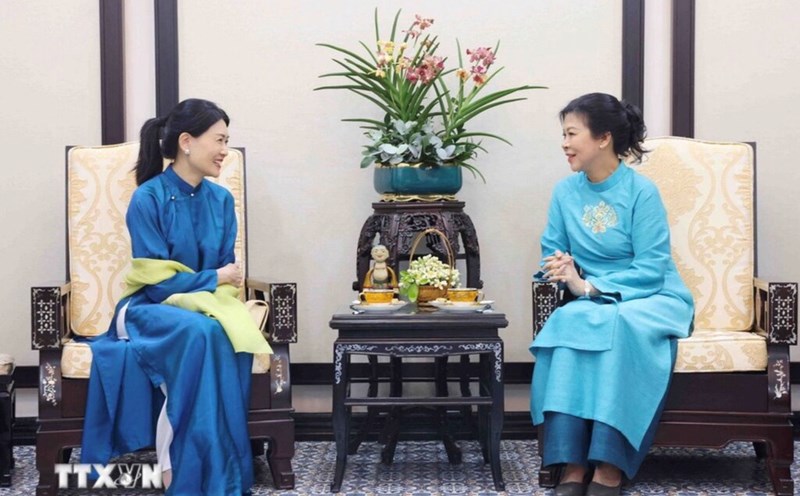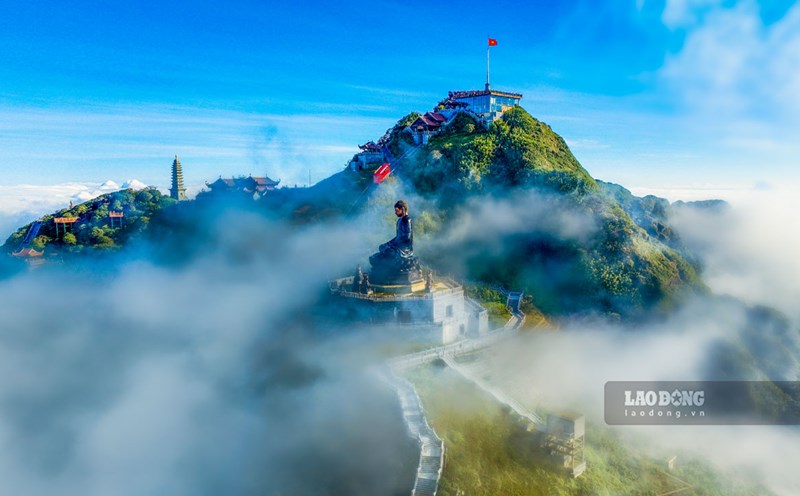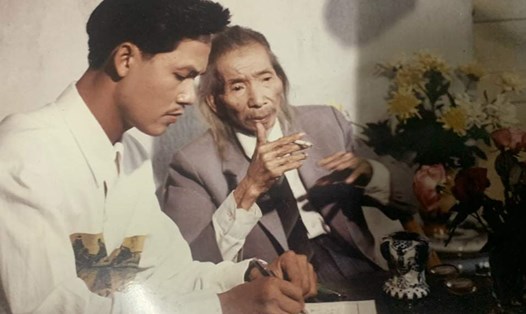The wind whistling past the cannon's muzzle, the temple bells ringing slowly in the air, your white shirt gone from afar, gone.
Then I stumble upon the final line that condenses the deep sadness hidden in the endless, making me dizzy: Time passes by, the face of the bronze peak is gray.
At that time, I did not know who Nguyen Duy, the author of the above poem, was. Nor did I have any need to know. Every day of “integration” with the “new life” was enough to make my face pale, let alone poetry. Turns out I was wrong. It, the poem of time passing by, making the face of a bronze peak pale, just “slowly” wandered into my unintentionally stored random memory, then hid somewhere waiting to be activated.
The Nine Tripod Cauldrons is a story passed down from generation to generation, and occasionally there is a chance to “republish” it in the extended family, at a “three-generation family meal”, or at a major memorial service… It seems to have been memorized, reserved only for the grandchildren to hear. Then, in the middle of a poor party, even with the “inner palace” style of plates and bowls, to bid farewell to the year of the Dragon (1976), when the story of our great-grandfather’s contribution to the production of the Nine Tripod Cauldrons had just ended, I suddenly recited the verse “time passes, turning the bronze cauldron’s face gray”. Everyone was stunned, stopped, looked at each other sadly, as if they were guilty towards their ancestors, towards time, and towards themselves.
Our spontaneous emotions soon died down. But Nguyen Duy's verse did not.
Half a century, exactly 48 years later, in late spring 2024, Nguyen Duy published a collection of poems about Hue, with the title that has always been the default: Time passes, the face of the bronze tripod turns gray.
Once again, the verse is like a query.It prompts and encourages me to write about the gray color of time, of which the Nine Urns is an artistic symbol.
Here is the excerpt:
* * * “In my experience, like several elders in my extended family, I have been haunted by an image of the natural world: the Wu Tong tree.
Why?Because it occasionally appears along the journey of transforming my perception of the nation’s history and culture.But the story of Wu Tong must begin with the Nine Urns cast under the Minh Mang Dynasty, consisting of nine large bronze urns arranged in front of Hien Lam Pavilion, opposite The Mieu Temple in the Imperial City, each urn named after a Nguyen Dynasty king, starting with Cao Dinh symbolizing the founder of the Nguyen Dynasty, Emperor Gia Long.On each urn are embossed 17 typical images from the fields of astronomy, geography, precious products and powerful weapons of Dai Nam at that time.
I occasionally entered the Imperial City, stopping for quite a while in front of Nhan Dinh, the cauldron dedicated to King Minh Mang himself, the Holy Ancestor Nhan Hoang De, who directly commanded the design and manufacture of the Nine Cauldrons for two consecutive years, from early winter 1835 to late spring 1837, looking intently at a carving on it related to the talented hands of my great-great-grandfather, with the question, "Among more than ten thousand species of plants in our country at that time, why Ngo Dong?"
My father also tutored me in French writing. Once, he chose a broad and difficult topic, "Chinese influence in Vietnamese literature". In the essay, I lamented: "Vietnamese poets of the past used many poetic metaphors from Chinese sources, for example "snow falls" or "Wu Tong falls", despite the fact that Vietnam has neither snow nor Wu Tong."
I remembered the opinions I had heard somewhere, but my knowledge of Han-Nom poetry at that time was zero. On the weekend afternoon, when I returned my papers, I only saw my father correcting the outline and of course spending a lot of time on grammar, which I was quite weak at. Then, following my father's suggestion, I pushed his wheelchair to the Imperial City for a walk. My father suddenly asked me if I had seen the Wu Tong tree. I shook my head. A moment later, we stopped in front of an ancient tree. "That Wu Tong tree," my father said. The tree was nearly 20 meters tall, at the time when it showed its true beauty: it had shed all its leaves, and all its flowers had bloomed, the clusters of purple-pink flowers shining for the last time in the sunset and in the thin mist.
I took my eyes off the Wu Tong tree and looked at my father with a grateful, and certainly radiant, smile. Suddenly remembering two lines of poetry, the kind of poetry that one can memorize without learning, "Wu Tong one leaf falls, The world knows autumn together", I hesitated, "Dad, are you sure it's Wu Tong? It's only late spring, but Wu Tong sheds its leaves and flowers in autumn?".
My father patted me on the back, "Good question. The Wu Tong you mentioned is the Wu Tong in China, which has become a symbol of autumn, Chinese autumn, with yellow flowers, or yellow with white spots. And in front of you right now is the Wu Tong that King Minh Mang himself sent people to find in Truong Son of our country, with purple-pink flowers blooming in late spring. The same species of tree but different in flower color and flowering season is because they grow in two different climates, tropical and temperate."
The joy that our country also has the Wu Tong tree could not hide my disappointment in myself, so I asked, "So I was wrong?". Patting me on the back, my father replied, "What you wrote in your essay is correct, because since before the Minh Mang dynasty, the Wu Tong tree of China has stood shoulder to shoulder with the pine tree, also known as Tung, and has a high frequency of appearance in Vietnamese poetry. However, your correctness is not based on a deep knowledge, which requires reading and experience. Why be sad, at your age, I could not write like that."
I wanted to hear more about King Minh Mang and the Dai Nam Ngo Dong tree, but my father said: "It's late, let's go home. The translations of Dai Nam Nhat Thong Chi and Minh Mang Chinh Yeu are in the bookshelf, you can find them yourself, you will find them more interesting."
A few years later, I submitted a research article to a cultural magazine. It included a retrospective of the story of Ngo Dong: "According to Dai Nam Nhat Thong Chi, after a period of joyfully receiving two Ngo Dong trees, a gift from Guangdong-China, which were believed to not exist in the Southern land, King Minh Mang ordered his men to lead soldiers carrying leaf samples and drawings of Ngo Dong trees into the forest to find the answer to his own troubling question: "So, does Dai Nam have Ngo Dong trees?"
It turns out that the royal tree full of poetic inspiration has been hidden for thousands of years in the green Truong Son mountains, waiting for the day when a king with a rare self-questioning sentence appeared in the South. From then on, the king decorated the architectural landscape of the palace and mausoleum with the domestic Ngo Dong variety. King Minh Mang's pride, not inferior to the North, was also shown through the carving of the image of the Dai Nam Ngo Dong tree on the Nine Urns.
It was not until many years later, when my hair was no longer green, and I could no longer remember thinking about that first article, that I had the opportunity to realize that the interpretation of "being proud not to be inferior to the North" that I attached to the heroic spirit of King Minh Mang, in the case of Ngo Dong, although not entirely wrong, was one-sided, and even offended my ancestors. The trip upstream of the A Vuong River, looking for the final pieces for the overall picture of a Katu cultural region, led me astray to a corner of the forest, which was one of the "cradles" of the "old man". In the distance, a large clump of trees had shed all their leaves, revealing the characteristic purple-pink flowers of Ngo Dong Dai Nam against the vast green background of the Truong Son range. The guide, the village elder of Ale village, stood still waiting for me to calm down my emotions, before adding, "The Katu people from my father's generation and earlier have the habit of occasionally looking up to the top of a high mountain in the spring. They still maintain the belief passed down from their ancestors: That the Phoenix will one day return through the clouds and mist, perching on that clump of Wu Tong trees. The ancient custom of hunting blood to worship Giang records this: When Katu men are intercepted and "asked for blood", they will sing the "ly" song:
In the morning I still want to see the sun rise in the East In the afternoon I still want to see the sun set in the West At midnight I still want to hear my beloved wife laugh under the blanket And in my dreams I still want to see the Phoenix return on the Wu Tong tree How can I give you blood?
The wild and remote forest scene of the distant past was vividly revived through the singing of "ly" and the illustrative movements of old man Katu with a long forest knife on his sinewy arm. I shivered involuntarily. Not because of fear of "asking for blood", but because I vaguely heard the flapping of the wings of the Phoenixes in the mist. The dream element and the unreal bird appeared too unexpectedly in the reasoning of the man in the highlands refusing to "give blood". It turns out that dreaming of seeing the restored golden age is also a reason for a person to live.
And today, reading the epilogue of the genealogy, I realized another mistake I made when writing about the Nine Urns: King Minh Mang ordered the casting of the Great Southern Wu Dong drawing on the Nhan Dinh, the urns reserved for himself, as a blank proof, to remind the king and the court officials to worry day and night about the important task of creating a golden age, like the Wu Dong tree constantly waiting for the Phoenix to part the clouds and fly back to perch on its branches, together completing the symbol of the couple - national peace and people's peace".
* * * The poem "Standing Up" by Phung Quan is real.
Because I am relying on the poem "Time Turns the Face of the Bronze Urns Gray" by Nguyen Duy to write a story.And continue into the endless multi-colored, multi-tonal, multi-dimensional time.
(Posted in the special publication Lao Dong Xuan At Ty).








